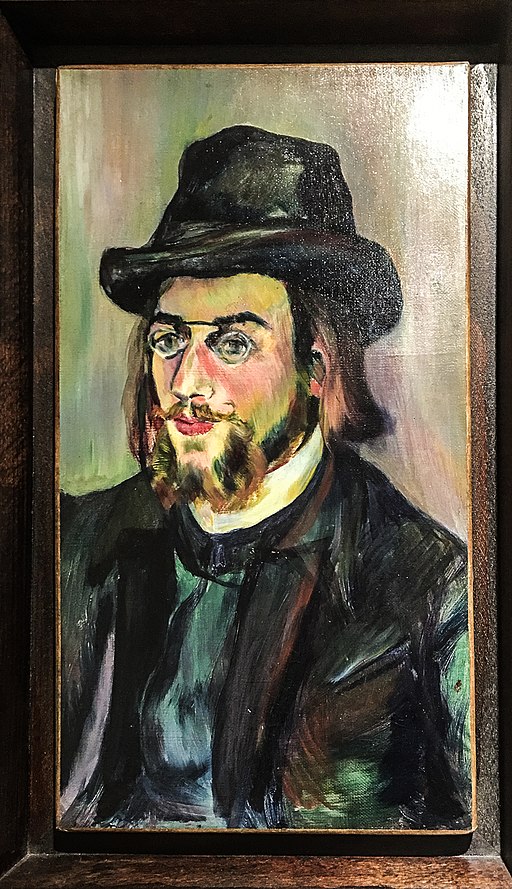 |
| Portrait d'Erik Satie 1892-1893 by Suzanne Valadon (Wikimedia) |
His music is very relaxing. It is sad and a bit lonely. It fit my high school years. It works well on rainy days.
Erik Satie died in 1925. Even his closest friends were shocked to find that this man, who was quite fashionable in public (a "velvet gentleman"), lived in a filthy, threadbare room. He had not allowed visitors for 27 years.
The lodging is now a museum dedicated to his life and work, but when he died, it was filled with newspapers and hoarded junk. There were two grand pianos placed one on top of the other. He played the bottom one, but the top piano was used as storage for letters and parcels.
I have always been intrigued by the fact that he collected many umbrellas. There was a room filled with umbrellas. I don't know if they were all closed, but I like to imagine they were all open.
Erik Satie died in 1925. Even his closest friends were shocked to find that this man, who was quite fashionable in public (a "velvet gentleman"), lived in a filthy, threadbare room. He had not allowed visitors for 27 years.
The lodging is now a museum dedicated to his life and work, but when he died, it was filled with newspapers and hoarded junk. There were two grand pianos placed one on top of the other. He played the bottom one, but the top piano was used as storage for letters and parcels.
I have always been intrigued by the fact that he collected many umbrellas. There was a room filled with umbrellas. I don't know if they were all closed, but I like to imagine they were all open.
His music, which evokes rainy days for me, might have been inspired by such days, and I can imagine him taking his daily walk on rainy days with a different umbrella each day. Maybe he "borrowed" some that were left at a cafe door.
His apartment may have been a mess, but when he went out for his daily 10km stroll to cafés and local Parisian haunts, he was immaculately groomed in one of seven identical grey suits he owned.
Satie was a colorful figure in the early 20th-century Parisian avant-garde. He was a precursor to later artistic movements such as minimalism, repetitive music, and the Theatre of the Absurd.
His apartment may have been a mess, but when he went out for his daily 10km stroll to cafés and local Parisian haunts, he was immaculately groomed in one of seven identical grey suits he owned.
Satie was a colorful figure in the early 20th-century Parisian avant-garde. He was a precursor to later artistic movements such as minimalism, repetitive music, and the Theatre of the Absurd.
The secretive and introverted Satie was an alcoholic who died from cirrhosis of the liver.
 | |
| Moulin de la Galette,1891 (detail of Erik Satie) by Ramon Casas |
Satie was introduced to the world as a "gymnopedist" in 1887, just before he wrote his Gymnopédies.
The title came from a made-up profession Satie invented for himself when asked what his occupation was. "I am a gymnopedist," he said. The word was highly esoteric — and the following year, Satie gave that title to three short piano pieces. What is a gymnopedist? One who writes the Gymnopédies, of course. The pieces were accompanied by a piece of verse written by Satie's friend J.P. Contamine de Latour, and it remains unclear whether the poem or the music was written first. The word "gymnopédie" appears in the poem, and had previously been identified by Rousseau as a piece of music to which young Spartans danced naked. (source)
Later, he also referred to himself as a "phonometrograph" or "phonometrician" - meaning "someone who measures and writes down sounds." They were designations that he preferred to that of "musician."
Since my youthful encounters with Satie's music, I have come to read more about him. There is a book of his writings, A Mammal’s Notebook: The Writings of Erik Satie. It's an odd and interesting book. Here is its description:
Although once dismissed as an eccentric, Satie has come to be seen as a key influence on modern music, and his writings reveal him as one of the most beguiling of absurdists, in the mode of Lewis Carroll or Edward Lear--but with a strong streak of Dadaism (a movement in which he participated).
The nonconformism of Satie's private life seems deliberately calculated: he assumed various personae at different periods of his life, from the mystical "velvet gentleman" to the Dadaist disguised as quizzical bureaucrat. His poignant, sly and witty writings embody all of his contradictions. Included here are his "autobiographical" "Memoirs of an Amnesic"; gnomic annotations to his musical scores ("For the Shrivelled and the Dimwits, I have written a suitably ponderous chorale … I dedicate this chorale to those who do not like me"); the publications of his private church; his absurdist play Medusa's Snare; advertising copy for his local suburban newspaper; and the mysterious, calligraphed "private advertisements" found stuffed behind his piano after his death.Satie referred to himself as "a man in the manner of Adam (he of Paradise)" and added: "My humor is reminiscent of Cromwell's. I am also indebted to Christopher Columbus, as the American spirit has sometimes tapped me on the shoulder, and I have joyfully felt its ironically icy bite." He died as he lived: "without quite ceasing to smile."
There are many ways to listen to Satie, from YouTube, Spotify, Pandora, from your local library's collection (they probably have at least one collection) or you might actually buy your own copy. The latter is a quaint idea these days but one Erik would probably prefer.



No comments:
Post a Comment